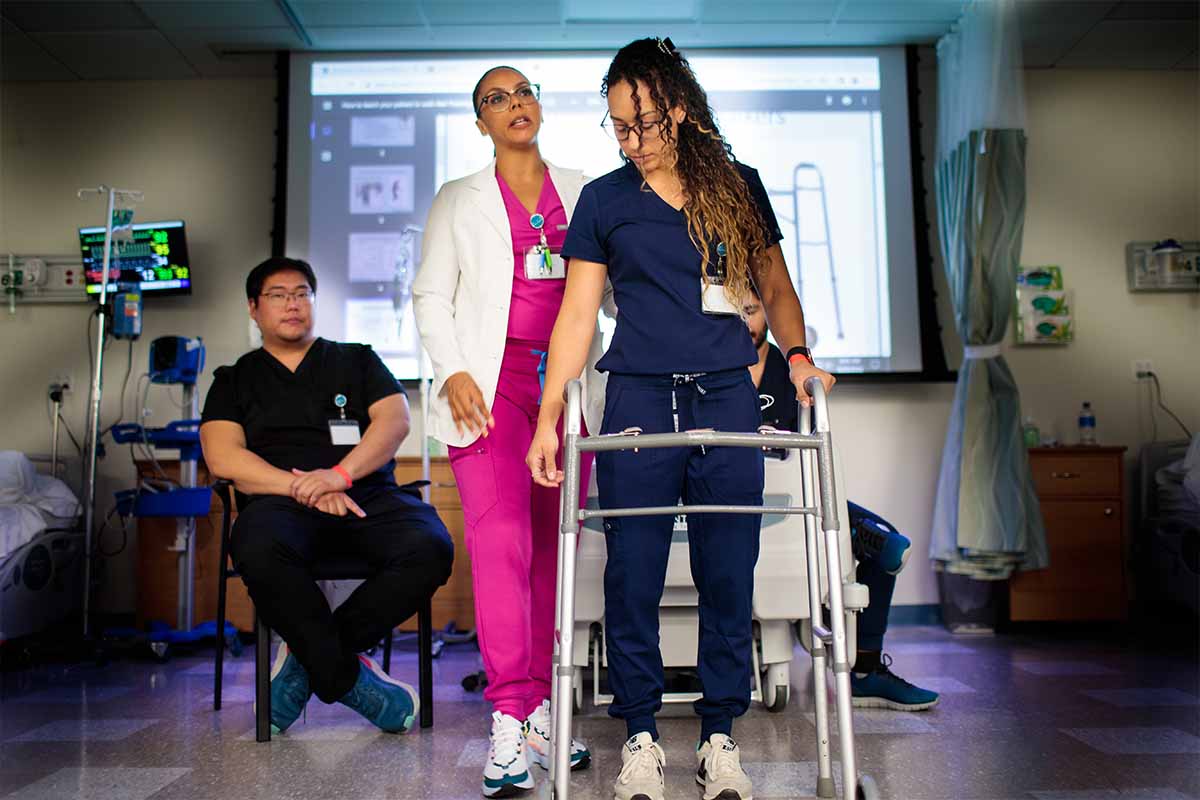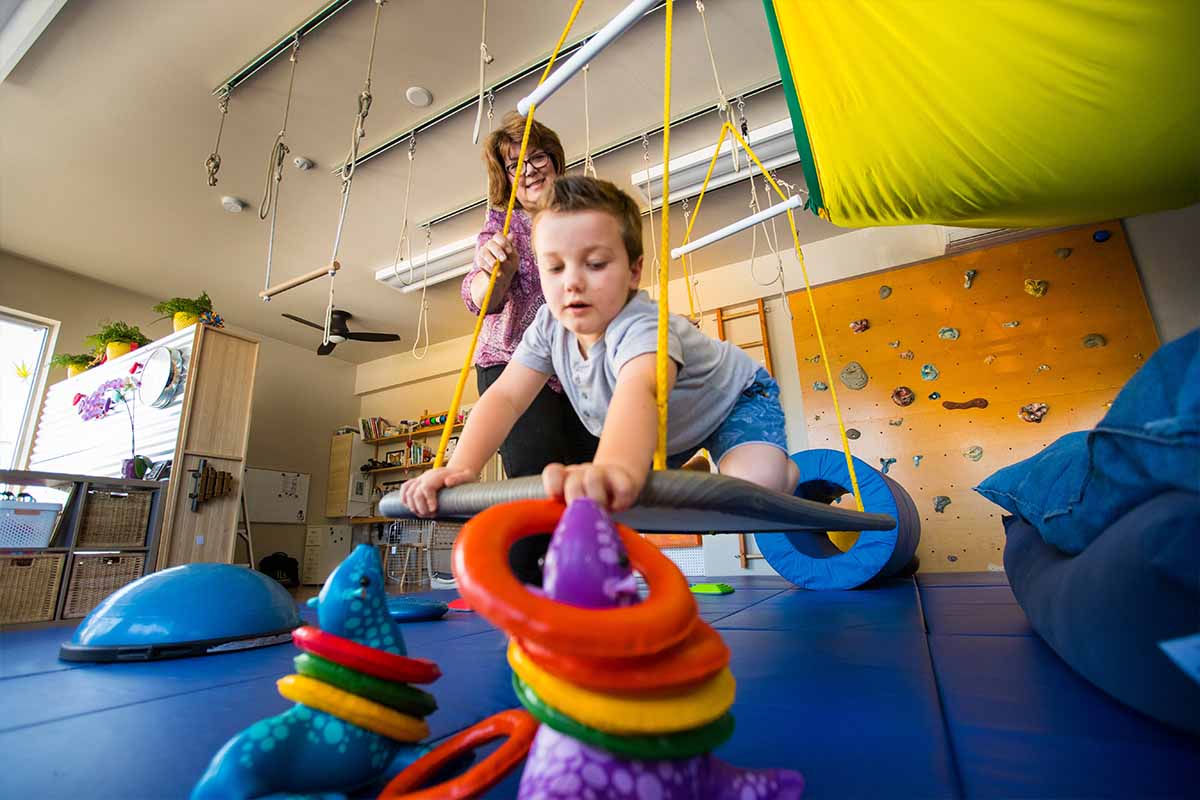
In a world where aging is often associated with decline, Kaelee Brockway, PT, DPT, EdD, and Keegan McKay, OTD, MOT, OTR, are inspired to challenge these ideas and invest in older adults. Their joint efforts with local community organizations and dedication to engaging students in the process are reshaping the future for seniors.
Breaking barriers in aging perception
Dr. Brockway, assistant professor of physical therapy (PT), and Dr. McKay, assistant professor of occupational therapy (OT), both at the University of St. Augustine for Health Sciences (USAHS) Dallas campus, bring a wealth of expertise to their roles. Dr. Brockway is board-certified in geriatrics and teaches geriatrics, cardiovascular and pulmonary courses. Dr. McKay’s focus lies in geriatrics and home health. The instructors share a passion for improving the aging experience for older adults.
For Dr. Brockway, age is never a limit.
“I have witnessed 100-year-olds accomplish the same tasks as 40-year-olds.”
What is their favorite part of their work? They defy stereotypes about aging. Dr. Brockway says she delights in shifting student perceptions of older adults, emphasizing that age does not equate to weakness. “As physical therapists, we get to improve the aging experience for people. Teaching students how to do that is exciting,” she says.
Dr. McKay echoes this sentiment, highlighting the importance of exposing students to all facets of health and wellness, especially when working with stroke or cardiac patients. “The biggest thing we want to give students is experiences that promote empathy,” he says.
For example, Dr. McKay’s students recently participated in a Dementia Live simulation – an opportunity for students to experience some of the disorientation and symptoms of dementia to understand the patients they will serve.
Dr. Brockway says her work grants her the opportunity to change perspectives about older adults. “I love breaking down that barrier every day.”


Igniting change through partnership
Dr. Brockway and Dr. McKay have teamed up with Fort Worth-based Sixty and Better, a nonprofit dedicated to enhancing the lives of older adults.
Programs such as Walk with the Doc offer health presentations and facilitate connections to providers for seniors as they exercise. Recent events have focused on fall risk, prevention and home assessment support.
Through this partnership, students gain valuable community service experience and actively participate in improving the quality of life for seniors. Dr. McKay says, “Students step out of their comfort zone and have fun engaging with participants.”
“Events like Walk the Doc showcase the positive side of aging and how OTs and PTs can help to improve the process,” Dr. Brockway says.
The Dallas OT and PT programs are expanding their relationship with Sixty and Better. They aim to offer home health services shortly to address access to care and transportation. “We hope to serve the community we are in and help patients live better where they are,” Dr. Brockway says.
USAHS PT students are also working with Tribe Wellness, a physical therapy (PT) and group exercise organization that helps people fight for function despite their diagnosis. USAHS Dallas faculty member and former amateur fighter Michael Braitsch, PT, DPT, leads Tribe Wellness. By incorporating therapeutic interventions like boxing and Tai Chi into PT, Tribe addresses physical health and fosters community engagement.
“Dr. Braitsch gets students involved and allows them to participate in research. He’s a wonderful contributor to our classes,” Dr. Brockway says.


Practical skills for future practitioners
What sets the professors’ approaches apart is their enthusiasm for applied learning. By immersing students in real-life contexts, such as home visits, they equip aspiring OTs and PTs with the skills and empathy to navigate complex cases effectively.
Dr. McKay explains, “Our patients typically have more than one diagnosis, which requires nuanced patient care. We’re preparing OT and PT students to problem solve to help older adults be as happy and independent as possible.”
The programs teach students to help patients access their homes and community. “We’ve spent a lot of time in patients’ homes. We look at functional movement and how we can modify the environment and strengthen patients,” Dr. Brockway says.
Physical therapists (PTs) and occupational therapists (OTs) work together to help patients perform daily activities safely and independently in their homes. “Our PT partners are great at focusing on safety with mobility, which translates well for us as OTs,” Dr. McKay says. “We focus on daily activities so that individuals can do the things that are important to them.” He says the opportunity for students to assess a patient’s home helps patients to be as safe and independent as possible.
Dr. Brockway and Dr. McKay’s commitment to interprofessional education is evident through partnerships with other healthcare professionals, ensuring students understand the importance of a holistic approach to patient care.
Dr. Brockway explains that older adults are multifaceted patients who require the support of a team. “Students need to know what will be expected of them when they graduate. Our goal is exposure to patients and other caregivers to help students visualize holistic care,” she says.
Dr. McKay agrees and says the great thing about USAHS is its focus on interprofessional education and the school community’s shared desire to see each other succeed.


Redefining OT and PT in aging care
As the field of PT and OT evolves, Dr. McKay and Dr. Brockway envision a future where these professions play a central role in primary care for aging adults. By prioritizing accessibility and wellness, they aim to reduce the burden on the healthcare system while empowering older adults to lead fulfilling lives.
Dr. Brockway asserts that PTs should be primary care providers, especially as patients age. “If someone has back pain, their first thought should be that they should see their PT.” She says that this reduces costs and facilitates better patient outcomes, especially with a physician shortage.
“Our goal is to make wellness more sustainable and heighten access to care. We can do this by making PT the first point of contact.”
Similarly, Dr. McKay advocates for more collaboration amongst healthcare professionals and a movement toward community-based OT programming. “OTs are working in more emerging areas and with additional populations. They are not only inside a clinic,” Dr. McKay says.
Through their transformative work, Dr. Brockway and Dr. McKay are redefining aging care and paving the way for a brighter future for older adults everywhere. They are more than educators; they are champions of change, dedicated to reshaping perceptions, preparing tomorrow’s practitioners and improving the lives of older adults—one step at a time.









